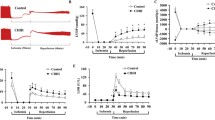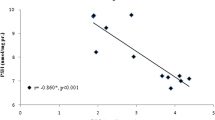Abstract
The purpose of this study was to appreciate the acute hypoxia-induced mitochondrial oxidative damage development and the role of adaptation to hypoxia/hyperoxia (H/H) in correction of mitochondrial dysfunction. It was demonstrated that long-term sessions of moderate H/H [5 cycles of 5 min hypoxia (10% O2 in N2) alternated with 5 min hyperoxia (30% O2 in N2) daily for two weeks]_attenuated basal and Fe2+/ascorbate-induced lipid peroxidation (LPO) as well as production of carbonyl proteins and H2O2 in liver mitochondria of rats exposed to acute severe hypoxia (7% O2 in N2, 60 min) in comparison with untreated animals. It was shown that H/H increases the activity of glutathione peroxidase (GPx), reduces hyperactivation of Mn-SOD, and decreases Cu,Zn-SOD activity as compared with untreated rats. It has been suggested that the induction of Mn-SOD protein expression and the coordinated action of Mn-SOD and GPx could be the mechanisms underlying protective effects of H/H, which promote the correction of the acute hypoxia-induced mitochondrial dysfunction. The increase in Mn-SOD protein synthesis without changes in Mn-SOD mRNA level under H/H pretreatment indicates that the Mn-SOD activity is most likely dependent on its posttranslational modification or on the redox state of liver mitochondria.
Similar content being viewed by others
References
Li C., Jackson R.M., Reactive species mechanisms of cellular hypoxia-reoxygenation injury, Am. J. Physiol., 2002, 282, C227–C241
Cadenas E., Mitochondrial free radical production and cell signaling, Mol. Aspects Med., 2004, 25, 17–26
Fujishiro N., Endo Y., Warashina A., Inoue M., Mechanisms for hypoxia detection in O2-sensitive cells, Jap. J. Physiol., 2004, 54, 109–123
Chandel N., Budinger G.,. The cellular basis for diverse responses to oxygen, Free Radic. Biol. Med., 2007, 42, 165–174
Bartosz G., Reactive oxygen species: destroyers or messengers?, Biochem. Pharmacol., 2009, 77, 1303–1315
Poyton R., Ball K., Castello P., Mitochondrial generation of free radicals and hypoxic signaling, Trends Endocrinol. Metabol., 2009, 20, 332–340
Okado-Matsumoto A., Fridovich I. Subcellular distribution of superoxide dismutase in rat liver, J. Biol Chem., 2001, 276, 38388–38393
Yu B.P., Cellular defenses against damage from reactive oxygen species, Physiol Rev., 1994, 74, 139–162
Clanton T.L., Klawitter P.F., Physiological and Genomic Consequences of Intermittent Hypoxia. Invited Review: Adaptive responses of skeletal muscle to intermittent hypoxia: the known and the unknown, J. Appl. Physiol., 2001, 90, 2476–2487
Vogt M., Puntschart, A., Geiser, J., Zuleger, C., Billeter, R., Hoppeler, H. Molecular adaptations in human skeletal muscle to endurance training under hypoxic conditions., J. Appl. Physiol., 2001, 91, 173–182
Sharp F., Ran R., Lu A., Tang Y., Strauss K., Glass T., et al., Hypoxic preconditioning protects against ischemic brain injury, Neuro Rx®., 2004, 1, 26–35
Lee E., Smith W., Quach H., Jones B., Moderate hyperoxia (40%) increases antioxidant levels in mouse tissue, J. Surg. Res., 2005, 127, 80–84
Gonchar O., Effect of intermittent hypoxia different regimes on mitochondrial lipid peroxidation and glutathione-redox balance in stressed rats, Cent. Eur. J. Biol., 2008, 3, 233–242
Gonchar O., Mankovskaya I., Effect of moderate hypoxia/reoxygenation on mitochondrial adaptation to acute severe hypoxia, Acta Biol. Hung., 2009. 60, 185–194
Bigdeli M., Preconditioning with prolonged normobaric hyperoxia induces ischemic tolerance partly by upregulation of antioxidant enzymes in rat brain tissue, Brain Res., 2009, 1260, 47–54
Lukyanova L.D., Novel approach to the understanding of molecular mechanisms of adaptation to hypoxia, In: Hargens A., Takeda N., Singal P. (Eds.), Adaptation Biology and Medicine, Vol. 4., Current Concepts, New Delhi: Narosa, 2005
Sazontova T.G., Arhipenko Y.V., Intermittent hypoxia in resistance of cardiac membrane structures:role of reactive oxygen species and redox signaling, In: Lei Hi, Serebrovskaya T. (Eds.), Intermittent hypoxia: from molecular mechanisms to clinical Application, Nova Science Publishers, Inc. New York, 2009
Bonfigli A., Colafarina S., Falone S., Di Giulio C., Di Ilio C., Amicarelli F., High levels of antioxidant enzymatic defence assure good protection against hypoxic stress in spontaneously diabetic rats, The Int. J. Biochem. Cell Biol., 2006, 38, 2196–2208
Shan X., Chi L., Ke Y., Luo C., Qian S., Gozal D., et al., Manganese superoxide dismutase protects mouse cortical neurons from chronic intermittent hypoxia-mediated oxidative damage, Neurobiol. Dis., 2007, 28, 206–215
Pardo M., Tirosh, O., Protective signaling effect of manganese superoxide dismutase in hypoxia-reoxygenation of hepatocytes, Free Radic. Res., 2009, 43, 1225–1239
Jonson D., Lardy H., Isolation of liver and kidney mitochondria, Methods Enzymol., 1967, 10, 94–96
Buege J., Aust S., Microsomal lipid peroxidation, Methods Enzymol., 1978, 32, 302–308
Levine R.L., Garland D., Oliver C.N., Amici A., Climent I., Lenz A., et al., Determination of carbonyl content in oxidatively modified proteins, Methods Enzymol., 1990, 186, 464–478
Huwiler M., Kohler H. Pseudo-catalytic degradation of hydrogen peroxide in the lactoperoxidase/H2O2/ iodide system, Eur. J. Biochem., 1984, 141, 69–74
Misra H., Fridovich I., The role of superoxide anion in the autoxidation of epinephrine and a simple assay superoxide dismutase, J. Biol. Chem., 1972, 247, 3170–3175
Flohe L., Gunzler W.A., Assay of glutathione peroxidase, Methods Enzymol., 1984, 105, 114–120
Laemmli U., Cleavage of structural proteins during the assembly of the head of bacteriophage T4, Nature, 1970, 227, 680–685
Dean R.T., Fu S., Stocker R., Davies M.J., Biochemistry and pathology of radical-mediated protein oxidation, Biochem J., 1997, 324, 1–18
Stadtman E.R., Berlett B.S., Resctive oxygenmediated protein oxidation in aging and disease, Drug Metab. Rev., 1998, 30, 225–243
Berlett B.S., Stadtman E.R. Protein oxidation in aging, disease, and oxidative stress, J Biol. Chem., 1997, 272, 20313–20316
Amstad P., Moret R., Cerutti P., Glutathione peroxidase compensates for the hypersensitivity of Cu,Zn-superoxide dismutase overproducers to oxidant stress, J. Biol. Chem., 1994, 269, 1606–1609
Kato H., Kogure K., Araki T., Liu X., Keto K., Itoyama Y., Immunohistochemical localization of superoxide dismutase in the hippocampus following ischemia in a gerbil model of ischemic tolerance, J. Cereb. Blood Metab., 1995, 15, 60–70
Fridovich I., Superoxide dismutases, Biochim. Biophys Acta., 1975, 877, 147–159
Yamakura F., Kawasaki H., Post-translational modifications of superoxide dysmutase, Biochim. Biophys. Acta., 2010, 1804, 318–325
Ho Y., Dey M., Crapo J., Antioxidant enzyme expression in rat lungs during hyperoxia, Am. J. Physiol., 1996, 270, L810–L818
Shen C., Lee J., Su C., Wang D., Chen C., Hypoxia and reoxygenation of the lung tissues induced mRNA expressions of superoxide dismutase and catalase and interventions from different antioxidants, Transplant Proc., 2008, 40, 182–184
Oh-Ishi S., Kitzaki T., Yamashita H., Nagata N., Suzuki K., Taniguchi N., et al., Alterations of superoxide dismutase iso-enzyme activity, content, and mRNA expression with aging in rat skeletal muscle, Mech. Aging Dev., 1996, 84, 65–76
Gonchar O., Mankovska. I., Activity and expression of the antioxidant enzyme MnSOD in the mitochondria during prolonged hypoxia/hyperoxia exposure, Int. J. Biol Chem., 2011, 5, 342–351
Gonchar O., Mankovskaya I., Antioxidant system in adaptation to intermittent hypoxia, J. Biol. Sci., 2010, 10, 545–554
Sen C., Packer L., Antioxidant and redox regulation of gene transcription, FASEB J., 1996, 10, 709–720
Haddad J.J., Antioxidant and prooxidant mechanisms in the regulation of redox(y)-sensitive transcription factors, Cell Sign., 2002, 14, 879–897
Jackson R., Parish G., Ho Y., Effects of hypoxia on expression of superoxide dismutases in cultured AT II cells and lung fibroblasts, Am. J. Physiol. Lung Cell Mol. Physiol., 1996, 271, L955–L962
Chen C., Tsai S., Ma M., Wu M., Hypoxic preconditioning enhanced renal superoxide dismutase levels in rats, J. Physiol., 2003, 552, 561–569
Saba H., Batinic-Haberle I., Munusamy S., Mitchell T., Lichti C., Megyesi J., et al., Manganese porphyrin reduce renal injury and mitochondrial damage during ischemia/reperfusion, Free Radic. Biol. Med., 2007, 42, 1571–1578
Keller J., Kindy M., Holtsberg F., Clai D., Yen H., Germeyer A., et al., Mitochondrial manganese superoxide dismutase prevents neural apoptosis and reduce ischemic brain injury: suppression of peroxynitrite production, lipid peroxidation, and mitochondrial dysfunction, J. Neurosci., 1998, 18, 687–697
Cruthirds D., Novak L., Akhi K., Sanders P., Thompson J., MacMillan-Crow L., Mitochondrial targets of oxidative stress during renal ischemia/ reperfusion, Arch Biochem. Biophys., 2003, 412, 27–33
MacMillan-Crow L., Cruthirds D., Manganase superoxide dismutase in disease, Free Radic. Res., 2001, 34, 325–326
Author information
Authors and Affiliations
Corresponding author
About this article
Cite this article
Gonchar, O.A., Mankovska, I.N. Moderate intermittent hypoxia/hyperoxia: implication for correction of mitochondrial dysfunction. cent.eur.j.biol. 7, 801–809 (2012). https://doi.org/10.2478/s11535-012-0072-x
Received:
Accepted:
Published:
Issue Date:
DOI: https://doi.org/10.2478/s11535-012-0072-x




